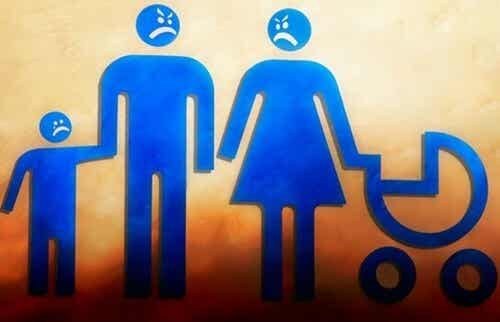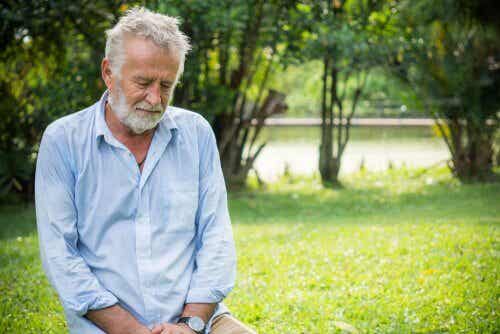The abandonment of the partner, of the parents, of a friend generates a wound that is not seen, but which pulsates every day.

Last update: December 17, 2022
The wound of the abandonment of the partner, of the parents in childhood or even of society you can't see it, but it pulsates every day. It is an uprooted root, a broken link that fed our emotions and our security.
Abandonment is not produced only by physical absence, but also from the absence of emotional authenticity, for which disinterest, apathy and coldness appear. The perception of this emptiness has no age; any child can feel it and it can wreak havoc on any adult.
It is often said that to understand what it means to be abandoned, "one must be abandoned". However, this is something that no one deserves, because with each absence we lose a part of ourselves, and no one should suffer such suffering.
The psychological consequences of an early abandonment experience are usually quite severe. Although each person reacts differently, traces of trauma remain.
The wound of abandonment: drifting boats laden with absences
The feeling of abandonment can manifest itself in many ways. We become boats adrift when, for example, we lose our jobs and do not find a way to re-enter the job market.
We remain stranded, like that child who is abandoned at an early age by his mother is lost, or like that man who one day on returning home discovers an empty house and the absence of the woman he loved.
On the Abandonment.net page, anyone who needs it can express their experience regarding abandonment. Many find it therapeutic to be able to share these experiences, but most of these testimonies speaks of a trauma that occurred at an early age: the death of a parent, having an alcoholic parent or being practically raised in solitude.
Being a victim of neglect in childhood is crucial. So much so that experts describe it as a second birth.
If the first was painful, but full of hope, the second forces us to "be reborn" in a world where we don't feel loved, where we have to learn to take care of ourselves following the rupture of that umbilical cord that united us to a heart, to emotions, to needs that had to be satisfied.
Consequences associated with emotional abandonment
When it comes to the consequences associated with a traumatic psychological dimension, it is important to keep in mind that they can be very different.
Not all people feel and express pain in the same way. However, we could summarize the consequences in the following points:
- Being abandoned in childhood often results in serious difficulties in establishing stable relationships in adulthood. It is common to be wary, to feel vulnerable, to go through moments of apathy, so it is very difficult to manage emotions such as anger or sadness.
- When a person suffers the abandonment of his partner or society he can also "sabotage himself" thinking that he does not deserve to be happy or loved, that he is good for nothing, that his dreams are no longer worth fighting for.
- Issues of codependency also appear, as approval and recognition are needed; in the same way, we get to give too much to others, but we feel that we are not receiving the same treatment. This addiction negatively affects emotional bonds.
- "Emotional reminiscences" are common. Sometimes something or someone reopens the wound of abandonment and the world stops.
- Depression and anxiety disorders are also common, for example the constant need for external validation, fear of rejection, and feelings of guilt and shame.
Those exposed are signs of severe PTSD that needs to be managed.
How to heal the wound of abandonment
The wound of abandonment must be healed by paying particular attention to self-esteem and, above all, knowing how to forgive, free oneself from that past like someone who cuts the thread of a balloon and lets it go.
- The therapy of desensitization and re-processing through eye movements (EMDR) is useful to detect and transform the traumatic memories of childhood. It allows the person to free their mind, body and to open their heart to offer them adequate emotional relief. Of course, you have to rely on a professional psychologist.
- It's important learn to communicate emotional needs. Through words, the injured person will be able to connect with others so as to be helped and supported, which will foster more stable relationships.
- Work to strengthen self-esteem it is essential to heal the wound of abandonment. Reconnecting with yourself, your hobbies, interests and dreams will be of great help in gradually taking control of your life, forging a bond of love with your being and recognizing the importance of becoming more autonomous and independent.
- Persevere in developing self-confidence and trust in others. Allowing yourself to establish new bonds will help you understand that the wound of abandonment can heal thanks to the love that is received throughout life. Likewise, that all bonds are transitory and that we can always connect emotionally with others.
Conclusions
Learning to take care of ourselves, to prioritize ourselves every day to gradually disconnect from anger and resentment, will free us from the wounds of yesterday.
Memory cannot erase the sadness of the past, but it can give calm and tranquility like someone watching a river flow.
Everything passes, and although the colder and darker stones remain on the bottom, the water flows clear and pure over them. You can start over.


























